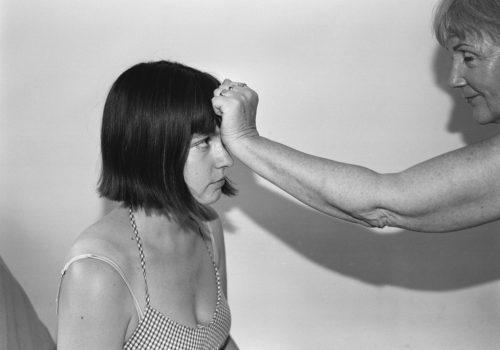LE BAL presents the first exhibition in France dedicated to the Polish artist Joanna Piotrowska, noticed at the last Venice Biennale and winner of the Lewis Baltz Research Fund (2018) initiated by LE BAL. For the past ten years, she has been developing a visual universe at the crossroads of photography and performance, which examines the complex and ambiguous relationships within the family circle.
Joanna Piotrowska in conversation (fragments) with Magdalena Komornicka
Magdalena Komornicka: Why photograph zoos?
Joanna Piotrowska: My interest in animal cages and enclosures animals in cages is an extension of the themes at play in my previous works, for example in the previous series Shelter which features precarious structures imagined and made by individuals to let them take shelter inside their own house. The cages have a showcase function, a decor in the center of which we place the animal like an object. We are confronted with two phenomena that are both significant and contradictory: on the one hand, protection and responsibility, and on the other hand, oppression and enslavement. This dichotomy is the starting point for most of my works. It is important for me to create such connections and to move from animal to human, from human to home, from home to cage, from cage to shelter, to safety, to privacy, touch. I navigate between these different points of reference, while trying to explore the links that unite them.
MK: Unlike your previous works, these are documentary photographs.
JP: Yes, the Enclosures are the only works for which I did not design a set up. It would be redundant because everything in the cages or enclosures has already been carefully thought out and laid out by someone else. In these artificial landscapes, purposely placed accessories have been installed, such as a tree trunk, a ball, a blanket, a plate of food, plants or artificial stones. Sometimes objects intended to “take care” or “stimulate” animals are ambiguous, such as toys or mirrors, they could be objects for children, or, on the contrary, instruments of torture. For example, there is a kind of pliers that looks like a pistol, an extension of the hand used to hold the animal at a distance.
MK: It’s interesting in view of your previous works, in which we find the theme of touch.
JP: Yes, there is a recurrence of the theme of touch in several of my works; with the Frowst series, in the context of intimate family relationships. I asked friends to design situations with me in which they would pose with members of their families in positions sometimes borrowed from “therapy” sessions and sometimes inspired by old photographs of themselves in family environment. The results are completely fictional situations photographed according to documentary conventions.
MK: Touch, the body and violence appear in the photographs representing young adolescent girls in poses taken from self-defense manuals.
JP: This work, like the Frowst series, comes from my interest in non-verbal communication and in therapeutic techniques based on the work of the body and not of the word. Since the body reacts to things such as our emotions, our flaws, it cannot remain indifferent to the socio-political context in which we evolve. When I discovered self-defense manuals, I was immediately fascinated by the fact that the body was immediately considered a weapon, and that all movements and gestures formed a sort of alphabet, independent body language. At that time, I was also reading Joining the Resistance, where Carol Gilligan describes how unconsciously teenage girls censor themselves, subordinate themselves to preconceived patterns of femininity or the internalized role of young girls in a patriarchal culture. The young girls and women in my photographs find themselves in domestic spaces, most often in their bedrooms, and in awkward positions. It is not immediately apparent that these bodies defend themselves. Nor are we given to see what they are defending themselves against. We only see that they are intensely related to something dangerous, which is located outside the frame.
Curators: Julie Héraut and Diane Dufour
Joanna Piotrwoska : Entre Nous
From February 15 to May 21, 20236,
LE BAL
impasse de la Défense
75018, Paris
www.le-bal.fr
















